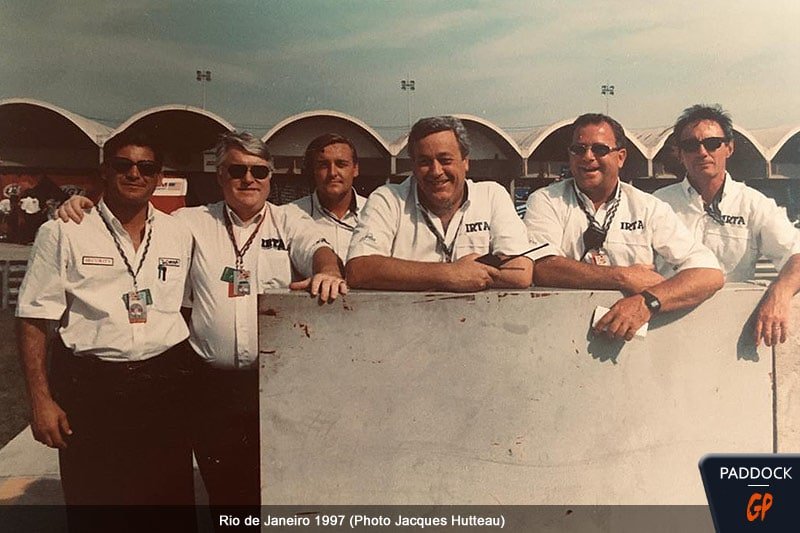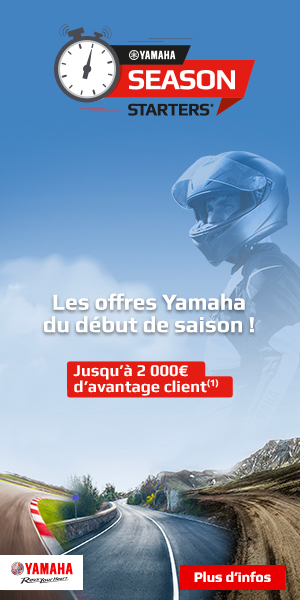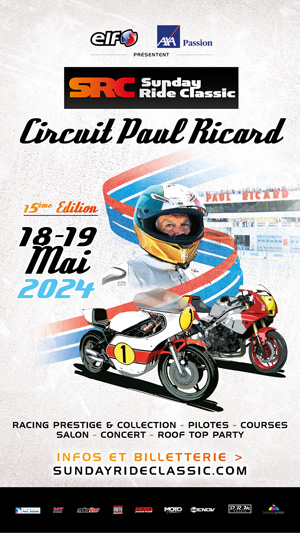In this series of articles, we will try to retrace what led to the creation of the IRTA (International Racing Team Association), one of the four entities which today manage MotoGP with Dorna Sports, the FIM and the MSMA.
Find here the first part concerning Kenny Roberts, Barry Sheene and the World Series project
Find here the second part concerning the period from the World Series to the drivers' strike at the French Grand Prix
Find here the third part concerning the drivers' strike at the French Grand Prix
Find here the fourth part concerning the birth of the association and recognition by the FIM
Find here the fifth part concerning the first steps… until Dorna arrives
Cover photo, from left to right: “Arturo”, Paul Butler, Tony Congraf, Mike Trimby, Niel Bird, Jacques Hutteau.
The contract with the company “Dorna Promoción del Deporte” was definitively signed on February 26, 1991 in Madrid by the FIM.
You might think things have finally stabilized, but it's quite the opposite!
En May 91, as a prelude to the Spanish Grand Prix in Jerez, the Spanish company presents itself to the international press…
Nick harris says: “during a chaotic press conference in Jerez in 1991, a Spanish company named Dorna Promoción del Deporte organized a media presentation to explain why their offer of $30 million to buy the television rights to the Grands Prix had been accepted by the FIM. The young Spanish translator was overwhelmed by the weight of the questions posed to the non-English speaking representatives of Dorna. At one point, Dorna's marketing director, Jaume Roures, slammed his fist on the table. »
Everyone thought he was tired of the anti-Dorna questions but he was actually trying to listen to the report of the Cadiz-Barcelona football match on the radio... since Dorna was also heavily involved in football.
This poor entry into Dorna Promocion del Deporte goes back to the FIM but has no consequences. The Spanish company is indeed raising the bar in June at Jarama, during a European Grand Prix replacing the Yugoslav Grand Prix in Rijeka.
Carmelo Ezpeleta (hired to manage the motorcycle part of the Spanish company, thanks to his past as creator and director of circuits, including that of Jarama) explains the words of Dorna Promoción del Deporte (Mundo Deportivo): “ We do not organize the race. This is done by RACE (Royal Automobile Club of Spain). Simply, we bet on it and we were responsible for financing it, finding sponsors and taking care of the promotion. We believe that much more can be done than has been done so far in this area. Currently, we contribute 3 million pesetas to the FIM and it is committed to donating 000% for the sport and keeping only 80% for its expenses. We believe that all objections are due to not knowing us. Now is obviously not the time to reveal our strategy, but we are going to spring more than one surprise. We will put on sale 20 tickets for the grandstand and 15 “Lawn” tickets. And we think we can sell them all. »
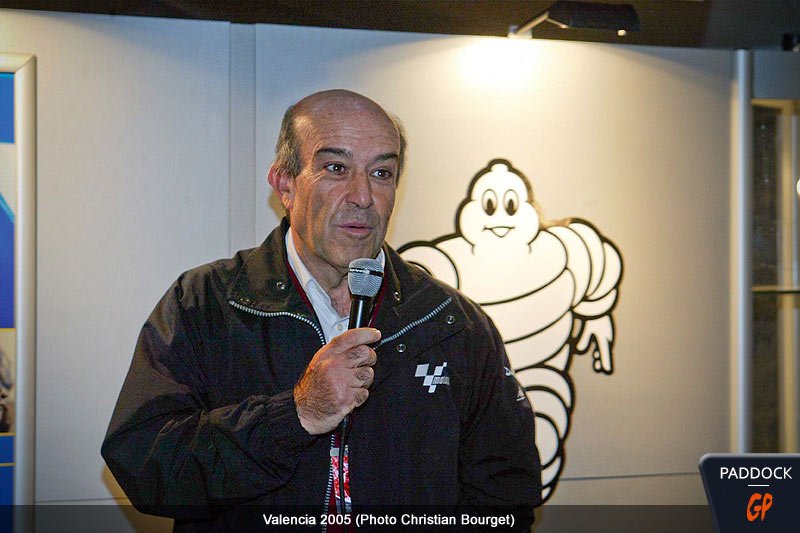
The IRTA, for its part, apparently focuses on security with, for example, a refusal of the Grand Prix in Sao Paulo, following an on-site visit by Mike Trimby and Kevin Schwantz to assess the safety of the Brazilian circuit. The latter is replaced by a race at Le Mans in September, which will be called the “Brazilian GP at Le Mans. »
But IRTA also receives the kind eyes oftireless returner, Bernie Ecclestone, who, upset at having been ousted from the management of TV rights, relaunched the idea of a parallel championship by taking advantage of both his past and fruitful experience in Formula 1, and the relative dissatisfaction of Japanese manufacturers with towards the FIM which wanted to force them to make drastic technical modifications in the premier category (2-stroke twin cylinders, then programming of 4-strokes). It is rumored that, to be convincing, Bernie Ecclestone promised IRTA $600 per race plus 000% of television revenues to pay for a field of drivers…
Although it has never been officially stated, it is rumored that this new championship would also be co-managed by Ion Tiriac, the tennis player's picturesque manager Boris Becker, and helped legally by Max Mosley, great friend of Bernie Ecclestone.
Mike Trimby : “It (Dorna’s arrival) actually pissed Bernie off and it certainly pissed us off. So Bernie, who had been courting us for about three or four years anyway, said: “Okay, that's it, we're going to separate from the FIM and run our own championship” »
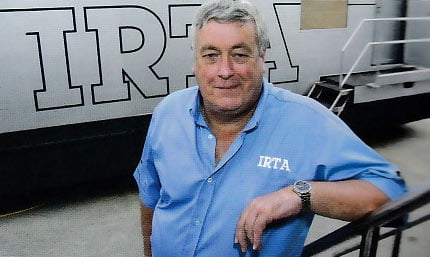
Obviously, the IRTA rating, acquired with difficulty since 1986 from the FIM (“a group of rebels” was their initial image), suddenly takes an old downward blow…
In September, Richard Golding (President of Dorna) and Carmelo Ezpeleta present the Iberian company to the members of the FIM council. On September 13,
Richard Golding sent a letter to the president
Vaessen in which he clearly states that the situation is extremely delicate because there is a real possibility of the creation of a parallel championship. An agreement had been signed between the IRTA and Bernie Ecclestone, which was likely to remove the Grands Prix from the domain of the FIM. In this agreement, IRTA would take care of sporting and technical regulations, Bernie Ecclestone of commercial and financial aspects.
The IRTA even modified its statutes during the last session in Brno because the status of associate member of the FIM was no longer compatible with its new objectives...
Problems were beginning to emerge, such as the Australian federation which had contacted Bernie Ecclestone about the new “World Series”…
For the FIM, it was really necessary to find a solution which would keep the Grands Prix under the authority of the international federation...
To react effectively to this kind of standoff, Dorna, the new ally of the FIM, needed all the weapons to be able to show that it could put forward arguments just as strong as those of the IRTA / Ecclestone duo which, moreover, , was favored by tobacco companies. To oppose Bernie Ecclestone's plans, she had to have the same rights as him, that is to say TV and marketing rights. In order to allow Dorna to find a solution, the president Vaessen, in some way cornered, even authorized the Spanish company to enter into negotiations with Bernie Ecclestone and his brand new company “ Two Wheel Promotions » created in September, negotiations whose content must however be submitted to the board of directors.
Richard Golding then indicates that he has already met Bernie Ecclestone twice and after difficult discussions, an agreement could be in sight!
The following week, the president
Jose Vaessen therefore goes to Barcelona where the F1 Grand Prix is taking place to discuss with
Golding et ecclestone. After a long discussion, an agreement was reached between the three parties, subject, of course, to the FIM management council accepting this solution. Of course, it would no longer be a question of the “World Series” but of the Grands Prix. Everyone (FIM, TWP, Dorna, IRTA) would work together in the same direction, with tasks divided between interested parties.
Two Wheel Promotions and Dorna undertake not to create or encourage two-wheel racing outside the authority of the FIM during this agreement, initially set for ten years. Of course,
Two Wheel Promotions also requests that the contract between the FIM and Dorna regarding the Grands Prix does not conflict with the TWP / IRTA agreement.
In summary, push cunning Bernie Ecclestone out the door, and he comes back through the window. The British businessman will have many detractors throughout his career… but he succeeded superbly!
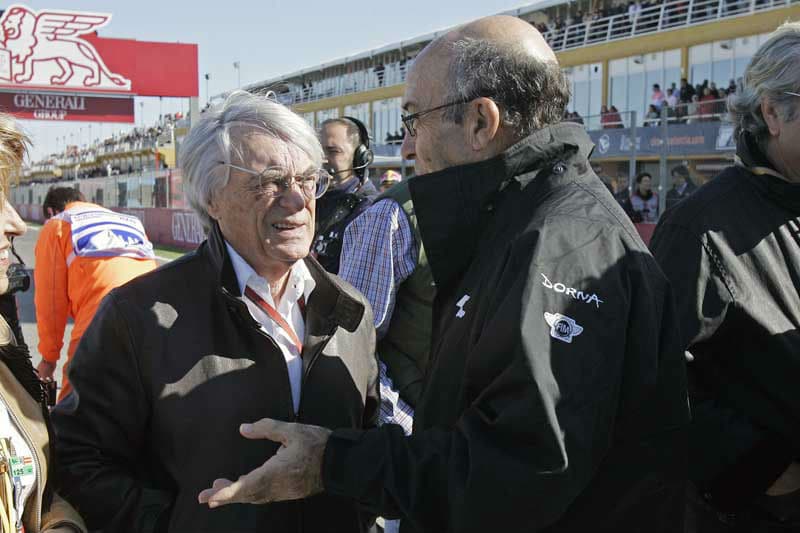
The 1991 FIM Congress was held at the end of October in New Zealand…
The atmosphere there is tense. A copy of the agreement reached in Barcelona was sent to all members of the board of directors. A document containing full details of the agreement following a final meeting between President Jos Vaessen and Messrs Ecclestone and Golding in London, just before he left for New Zealand, was also distributed.
Faced with opposition from the board of directors on this agreement, the president pointed out that he had not legally committed the FIM, because he alone had signed it (to be valid, an FIM contract also had to be signed by the Secretary General). Under these conditions, he proposes that the council recommends to the general assembly not to accept this agreement (!) and to accept a modified proposal in its place.
It feels like a vaudeville show when Richard Golding informs the FIM by telephone of the signing of a contract which is now effective between Dorna and Two Wheel Promotions, for a period of 5 years until December 31, 1996.
President Jose Vaessen wields the carrot and the stick, launching a call for unity between the national federations so that the resolutions adopted for the Grands Prix are respected and asking the federations to convince their circuits and their drivers to remain within the FIM jurisdiction, while making adopt the following resolution: “A road racing circuit used for an event not organized under the auspices of the FIM will no longer be designated for any international and/or national FIM event. »
The FIM then received decisive support, that of the Japanese manufacturers who had met on October 14 and 15 and, finally, declared their commitment to supporting the FIM in agreement with the Japanese federation, as long as they built motorcycles . They point out that they produce the essential tools for motorcycle racing and that, without their support, neither the Grands Prix nor the new World Series would survive.
The national federations then press the president Vaessen de “find an agreement to recover the GPs”.
A meeting was organized in London on November 15, 1991. For the FIM, it brought together the president Jose Vaessen, the vice president Francesco Zerbi and the president of the CCR, Joseph Zegwaard. In front of them are Richard Golding, executive director of Dorna, and Bernie Ecclestone, executive director of Two Wheel Promotions (TWP).
A new project is put on paper:
– Calendar: the country, circuit and date of each race would be proposed by TWP (Bernie Ecclestone). The calendar should be ratified by the FIM.
– The calendar would be made up of 14 GPs in 14 different countries and an additional GP for a federation without a circuit. A change could only be made with the unanimous approval of the permanent council or in the event of force majeure, or cancellation by a promoter.
– Sidecars would remain a GP category with at least eight races.
– Drivers: the maximum number of drivers per GP would be 30 for each individual category and 20 for sidecars.
– Regulations: the regulations in force would remain the regulations as defined in the agreement of October 1 between TWP, IRTA and the teams.
– Proposals for change could be made by Dorna or TWP; but in each case the FIM had the right of veto. Changes to safety standards, the medical code or the disciplinary code would be made by the FIM.
– Circuits: homologation inspections would be the responsibility of the FIM.
– The permanent bureau would be composed of the president of the FIM, a representative of Dorna and a representative of TWP. The FIM would be obliged to send a representative to each GP. The chief steward would be appointed by the FIM and would be the supreme authority, so he must be present at every GP. The safety official and the starter would be appointed by the FIM in agreement with the standing committee and must be present at each GP. The national federations would appoint the race director.
– Dorna / TWP would be responsible for the pass system.
– The pilots would be paid by Dorna / TWP.
– The FIM would terminate the contract with MotoMedia before December 31, 1991.
– The contract between the FIM and Dorna, signed on February 26, 1991, would be terminated with immediate effect, neither party being obligated in any way towards the other. Considering the new project, Dorna would pay the FIM the following sums: 4 million dollars in 1992, 1993 and 1994, 5 million in 1996 and 1997 and 6 million from 1997 to 2001, if the agreements were still valid and formal and had been signed within six months of November 15, 1991.
It is already a working basis which has the merit of establishing everyone's prerogatives, but which is far from being unanimous among the stakeholders in the world championship: Japanese manufacturers do not want to hear about any regulations other than those of the FIM (always threatening to no longer supply machines if this was not the case) and want a greater number of drivers per category, while certain national federations, under pressure from their organizers who were less inclined to pay higher fees, had started to take an interest in the IRTA / Ecclestone proposal (which were still playing on two sides at that time...).
The contract between the FIM and MotoMedia (IRTA / ROPA) was terminated on December 31, 1991.
During the winter of 1991/1992, FIM meetings followed one another and the project was refined, trying to satisfy more or less everyone. Japanese manufacturers send a letter to Michel Métraux (IRTA) requesting that the number of riders be increased to 36 and that the FIM technical regulations (not far removed from those of the IRTA) be applied otherwise they would not provide the machines for the Grands Prix.
Finally, the contract between the FIM and TWP / Dorna was formalized during the Geneva meetings which took place from February 28 to March 2, 1992.
IRTA retains at least for 5 years a certain management of sporting and technical regulations, despite pressure from Japanese manufacturers, but no longer has any relationship with TV rights.
Mike Trimby however remains a good player: “He's not my favorite person, but without Bernie it wouldn't have happened. Without the power that Bernie had and the ability to negotiate that Bernie had, all in all, this would never have happened. I don't think he made a quick move, I think he saw things evolving and saw how he could take advantage of it. And at the same time, he made everyone happy. The FIM got paid for rights they never had before, six or seven million a year or something like that, Dorna got the television rights, which was what they were looking for, Bernie organized the events and we got a lot more money for the teams and the right to define the sporting and technical rules. Everyone was happy. »
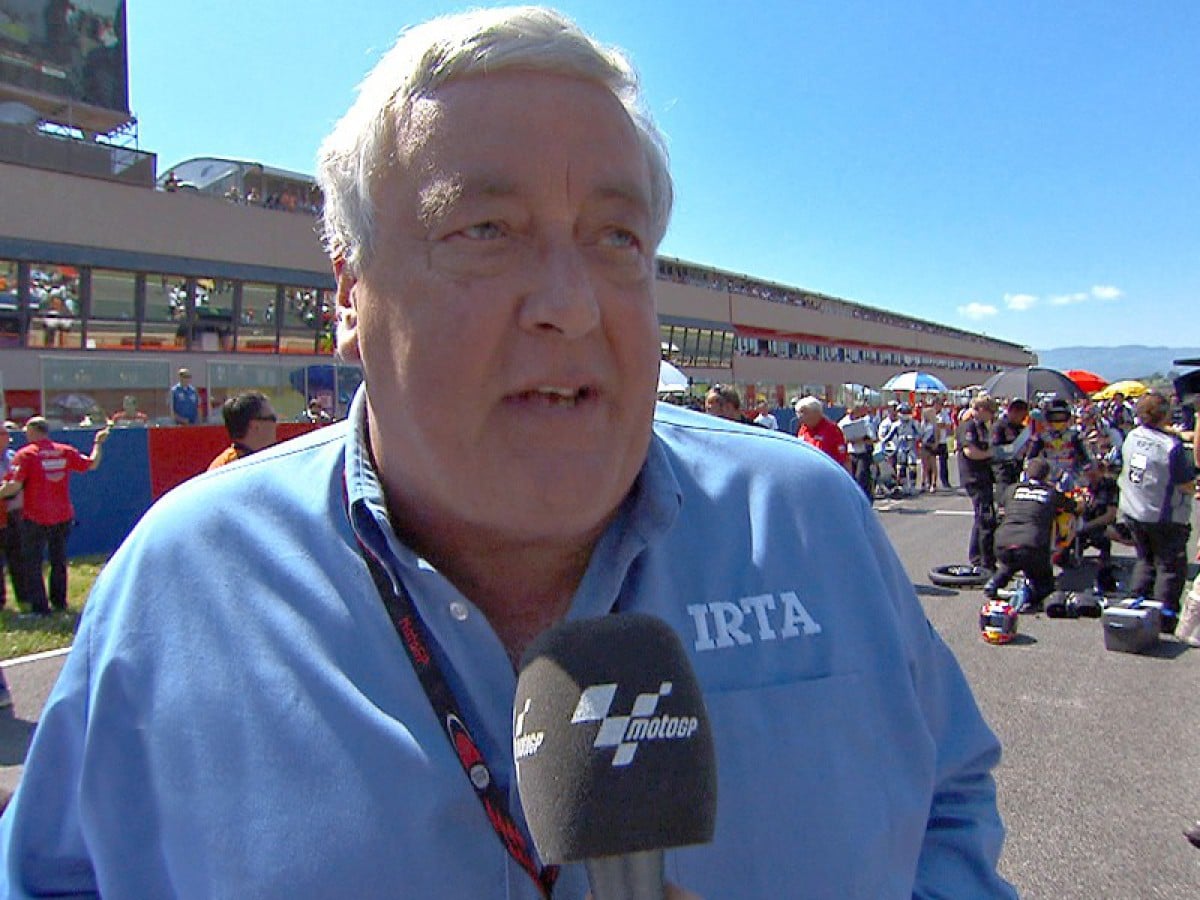
Bernie Ecclestone is justified: “The initial plan with IRTA would have been much less costly for the developers, but we ran out of time and were forced to compromise with Dorna. »
The FIM owes a debt of gratitude to the Japanese manufacturers, Honda in the lead (because Yamaha was tempted by the sirens of the new World Series): the FIM will not forget it, ask KTM and Ducati…
To have even more strength, Japanese manufacturers created the GPMA (Grand Prix Manufacturers Association) which in the early 2000s would become the MSMA extension
(Motorcycle Sports Manufacturers' Association) that we know today.
On a sporting level, the 1992 season went well overall.
To normalize its relations with the FIM, IRTA then refocuses on its core business, namely defending the interests of teams and drivers. Over the years, the association will also be involved at the financial level, since, in a way, it is it which provides the spectacle (it pays the teams race by race) and invoices Dorna for it.
April 1993 saw another twist, when Bernie Ecclestone sold a majority stake in his company Two Wheel Promotions to Dorna, for a supposed sum of 50 million pounds sterling: a nice coup for a company that was not yet two years old!
The 20 October 1995, Francesco Zerbi, president of the Italian federation, won the presidency of the FIM against Jos Vaessen, with 66 votes against 63. Recalling that the contract between the FIM and Dorna / TWP, signed in December 1994 by president Jos Vaessen, will expire at the end of 2006, he contact quickly Dorna / TWP to see how the ceded powers could be returned to the national federations and the FIM before this date. Dorna / TWP is not unfavorable to the idea, because on December 31, 1996, the promoter will no longer be linked to the IRTA to which it had transferred almost entirely the sporting and technical power via a contract signed in 1991.
After long individual conversations between gentlemen
Zerbi, Ecclestone and Ezpeleta, the president of the FIM explains his intentions during a press conference in Jerez during the 1996 season:
It is certain that whoever directs the GPs in the future will have to accept that sporting and technical rights once again fall under the jurisdiction of the FIM. In particular, licenses would again be issued by the federation, registrations for the world championship would again go through the FIM and the regulations would again be subject to the approval of the FIM. A select committee was to be set up for this purpose, on which manufacturers, teams, riders, suppliers and sponsors would be represented. In case of unanimous approval, the decisions would be adopted, otherwise the FIM would decide…
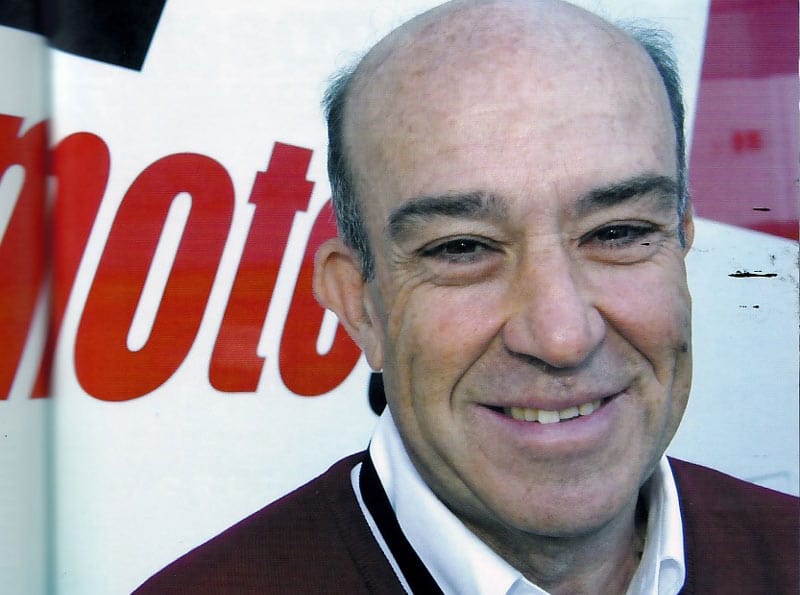
The FIM Board of Directors meets on September 7 and 8 and formalizes the new FIM / Dorna / TWP agreement. The main amendments are:
- La FIM takes over the authority and responsibility for the sporting, technical and medical regulations of the Grands Prix,
– GP drivers’ licenses are issued by the FIM with the agreement of the rider’s national federation,
– The homologation of circuits remained the exclusive responsibility of the FIM.
– The calendar would be proposed by Dorna / TWP then had to be ratified and published by the FIM.
– Changes could be proposed by any party represented and the final decision would be taken by the permanent council in which the FIM had the right of veto. If there was unanimous agreement within the commission, the decision would automatically come into force (Grand Prix Commission).
Even though he only had a brief stint in the motorcycle world, Bernie Ecclestone performed particularly well. Its dual association with Dorna and IRTA could have allowed it to do without the FIM if the Japanese manufacturers, mainly Honda, had not been absolutely loyal to the international federation.
At the end of 1996, the stakeholders were (finally) generally stabilized, each in their role and in close collaboration, which will allow over the years to progress the Grands Prix to the levels reached in recent seasons.
In the end, as Mike Trimby says, this whole period of standoff will have been beneficial for everyone, except obviously for the private drivers who, due to costs, can no longer enter the world championship with their own motorcycle.
Elected to the IRTA Committee in 1986, shortly after the founding of the Association, Site Pons was appointed Vice Chairman of the Committee in 1992 then Chairman in 1997, thus taking over from Michel Métraux.
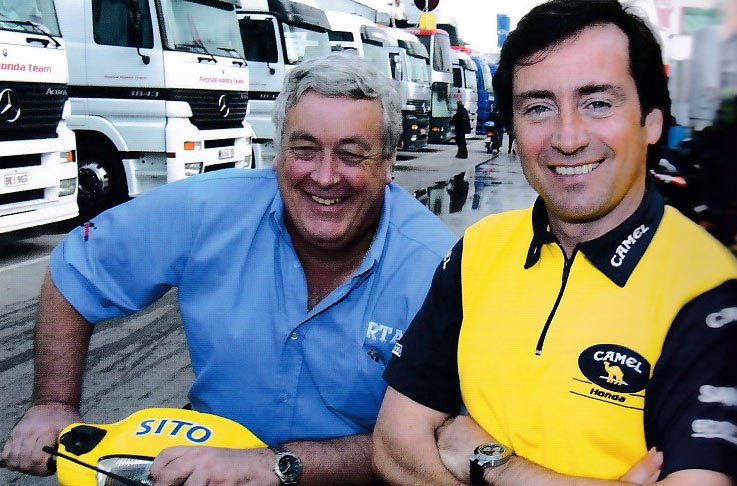
Member of the IRTA committee since 1997, Hervé Poncharal, manager of the French MotoGP Tech 3 Yamaha team, takes over from Site Pons as President of IRTA on March 1, 2006 in Barcelona. It still is to this day.
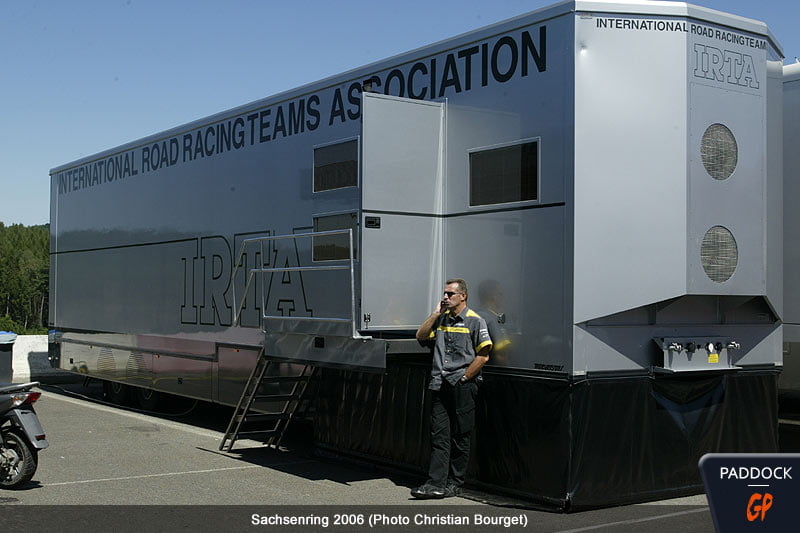
Since 2001, Michel Métraux (deceased) and Serge Rosset are no longer directors of the company MotoMedia, for the benefit ofOlivier Métraux (son of Michel) and Mike Trimby. This was renamed IRTA SA on May 7, 2004.
To be continued…
Find here the first part concerning Kenny Roberts, Barry Sheene and the World Series project
Find here the second part concerning the period from the World Series to the drivers' strike at the French Grand Prix
Find here the third part concerning the drivers' strike at the French Grand Prix
Find here the fourth part concerning the birth of the association and recognition by the FIM
Find here the fifth part concerning the first steps… until Dorna arrives
Credits: FIM, IRTA, Mundo Deportivo, Nick Harris, Cycle World Magazine, Terry Lovell, Bikesportnews, Business F1, etc.










